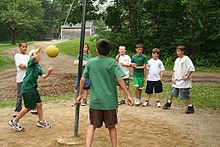Game With Ball On Pole

Tetherball is a game where 2 players use their easily to strike a volleyball which is suspended from a stationary metal pole that is suspended by a rope or tether. The two players stand on opposite sides of the pole, and each tries to hit the ball ane way; one clockwise, and ane counterclockwise. The game ends when 1 role player manages to wind the ball all the fashion around the pole so that it is stopped by the rope. It must not bounce.[one]

Swingball with the use of racquets
An early variant described in Jessie H. Bancroft'due south 1909 volume Games for the Playground... involves a tethered tennis ball hit by racquets, with similar rules of the game.[2] This variant is known every bit swingball, which was invented by Gavin Gormely in South Africa.[3] [four] The variation of the game with the volleyball, known as tetherball now, did non come up virtually until to invention of the volleyball onetime afterwards 1895.[5] In the 1920s, schools and parks began calculation them to their play area.[5]
The game begins when one player serves the ball, normally by holding it in 1 hand and hitting it with the other. The opposing player then attempts to return the serve by hit information technology in the contrary direction. The object is to striking the brawl in such a manner that one's opponent will be unable to alter the ball's direction. This gives the server an reward since the server has more command over the ball from the starting time. It is generally acceptable to hit the brawl with either the fist or the open up hand or swing.
A player commits a violation if they step onto their opponent's half of the pole, by touching the rope instead of the ball, hitting the ball before it has either circled the pole or been returned by the opponent or, in some variants, struck the pole. Generally, after a violation occurs, the game pauses and the person who committed the violation is out; the number of wraps around the pole is re-created (or a penalisation-wrap is awarded to the player who did not commit the foul). The histrion who did not commit the violation then serves the ball. If, nevertheless, the violation appears to be intentional, it may result in loss of game. One variation legalizes throws and double hits.
The game ends when one player hits the ball effectually the pole in their own direction as far equally it will get, so that the ball hits the pole. In add-on, the ball must strike the pole with the last wrap in a higher place a line marked on the pole. A 5-foot-high (1.5 m) marker is satisfactory, though a lower mark might exist used for younger players. A lucifer can get on for at least two or more games. If a histrion breaks any of these rules, they are out and it is the next person's turn to play the winner. If played with only 2 people, the "loser" now gets their plow to serve to even out the odds for their win.
Equipment [edit]

Tetherball requires a stationary pole, a rope, and a ball. The ball is roughly the size and weight of a volleyball, simply is somewhat firmer unless a soft tetherball is specifically purchased. Tetherballs usually take a bar recessed in the meridian that the rope is tied to. Some simply accept loops that protrude out, but this is less common every bit striking the loop with the hand can be painful.
The pole is often x feet (iii.0 m) high, and can exist as low equally 7 feet (ii.1 k) high depending upon the meridian of the players.[6] To proceed the pole stationary, it is either anchored down by using a concrete-filled tire or a accident molded plastic base filled with sand or h2o or in some cases physical, or is embedded in the ground. The rope is mostly slender nylon, and is long enough so that the ball hangs about ii feet (0.61 m) in a higher place the ground. The rope is generally 8 feet to 10 feet long.[vii]
Tetherball is played on many surfaces, including sand, gravel, backyard, and asphalt. It is common particularly in schoolyards due to the ease of setting up, and the long-lasting equipment- different other ball games where the ball can be destroyed or lost.
References [edit]
- ^ Maguire, Jack (1990). Hopscotch, hangman, hot potato, and ha, ha, ha: a rulebook of children'southward games . Simon and Schuster. pp. 177. ISBN9780671763329.
- ^ Bancroft, Jessie H. (1922). Games for the Playground, Abode, Schoolhouse and Gymnasium. Macmillan Visitor, New York. pp. 409–411.
- ^ "The History of Swingball". Swingball . Retrieved 2022-10-20 .
- ^ "Mookie History". Mookie Toys . Retrieved 2022-10-20 .
- ^ a b Sidekick, Author Backyard (2020-06-16). "How Was Tetherball Invented: Tetherball History". Lawn Sidekick . Retrieved 2022-10-20 .
- ^ "Tetherball Pole Regulations". SportsRec . Retrieved 2021-06-16 .
- ^ "Preview unavailable - ProQuest". www.proquest.com. ProQuest 138919070. Retrieved 2022-10-20 .
Game With Ball On Pole,
Source: https://en.wikipedia.org/wiki/Tetherball#:~:text=Tetherball%20is%20a%20game%20where,one%20clockwise%2C%20and%20one%20counterclockwise.
Posted by: richardsonnounkilthe.blogspot.com


0 Response to "Game With Ball On Pole"
Post a Comment